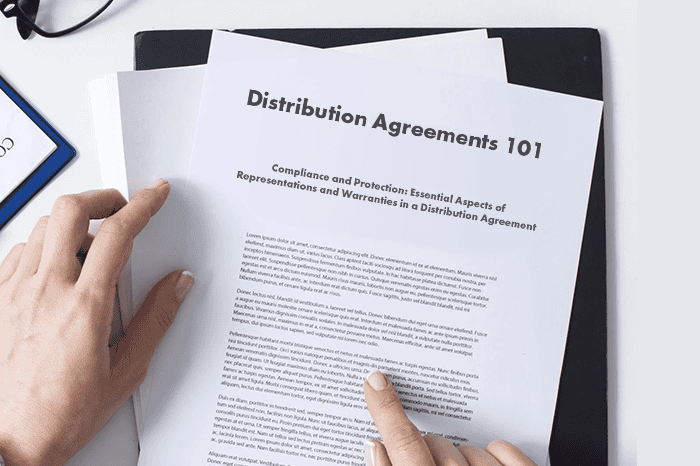Table of Contents

A distribution agreement is a legally enforceable contract that facilitates the exchange between a supplier and a distributor. A distributor assumes the responsibility of selling the goods and services of another company after purchasing it at an agreed price. The distribution agreement allows the supplying company to focus on development and production without securing resources for marketing and sale. It can be a mutually beneficial deal.
Distribution agreements include representations and warranties that help establish the rights and obligations of the parties involved in the deal. Additionally, it ensures that each party understands and agrees to their respective responsibilities. Compliance and protection are critical aspects of representations and warranties in a distribution agreement.
Essential Aspects of Representation and Warranties in a Distribution Agreement
In a distribution agreement, a representation and warranty is a legal statement made by one party to the other. Usually, the supplier provides these warranties to the distributor. These statements are intended to ensure that the distributor is fully informed about the products they are selling and that the supplier is legally liable for any misrepresentations or defects in their products.
The supplier makes many representations and warranties to the distributor in a distribution agreement, including product quality and other assurances. The supplier provides an assurance that the products are of good quality, meet the agreement’s specifications, and are fit for their intended purpose. The supplier also warrants that the products belong to them or that they have the right to sell them. They need to show their distributors that the sale of the products does not violate any intellectual property rights. This includes a guarantee that the products comply with all applicable laws and regulations surrounding safety regulations, labelling, and environmental standards.
A distribution agreement requires the supplier to assure that all material information about the products, including its defects, recalls, or potential liabilities have been appropriately disclosed prior to purchase. The supplying company should agree to not hold the distributor liable for any losses, damages, or expenses incurred as a result of any breach of the representations and warranties.
These representations and warranties assist both parties to build trust and serve as a foundation for lawsuits in the event of a dispute or potential breach of the agreement. It is critical that both parties carefully review and negotiate the terms of the representations and warranties to ensure that they accurately reflect both parties’ obligations , expectations and intentions.
Compliance and Protection within a distribution agreement
Compliance means that each party must follow all applicable laws and regulations that have been outlined by the relevant laws and the distribution agreement. In a distribution agreement, this frequently means that the distributor must follow all applicable laws regarding product distribution, including any labelling, packaging, and advertising regulations. The manufacturer, on the other hand, is responsible for ensuring that the products meet all relevant safety and quality regulations. Both parties can be assured that they are following all legal requirements by including compliance as a representation and warranty.
The measures taken to protect each party’s interests in the distribution agreement are referred to as protection. This may include safeguards against infringement of intellectual property, product liability claims, or breaches of confidentiality. Representations and warranties can be used to define the scope of these safeguards and to ensure that each party is responsible for taking appropriate precautions.
Compliance and protection are important considerations in a distribution agreement because they help to establish each party’s rights and responsibilities while also protecting against potential legal or financial risks. Parties must follow all applicable laws and regulations. The agreement should clearly outline each party’s obligations in terms of adhering to applicable laws and regulations, such as those governing product safety, labeling, and marketing. The agreement should also include provisions to protect both parties’ intellectual property rights, such as trademarks, copyrights, or patents. For a limited time, a supplier can grant the distributor the right to use their intellectual property.
The distribution agreement should specify the scope of each party’s liability and provide for indemnification in the event of any claims or damages arising from product distribution. This will help each party understand the potential consequences of contract violation. Furthermore, as a process for resolving disputes, the agreement should include dispute resolution provisions. To avoid costly and time-consuming litigation, this can be accomplished through mediation or arbitration.
Termination clauses are also important in motivating compliance. The agreement should specify the conditions under which either party may terminate the agreement, as well as the procedures that must be followed in such cases. Because a breach of confidentiality generally results in the termination of the contract, confidentiality, and non-disclosure are linked to the termination clause. The agreement should include provisions that protect the confidentiality of any proprietary or confidential information shared between the parties and prohibit its disclosure to third parties.
For the sake of the supplier, the agreement should establish procedures for monitoring and reporting on the performance of the distributor. This protects the suppliers’ interests and ensures that the distributor is performing their due diligence. Reports on sales, inventory levels, warehouse supervision, and customer feedback are some examples of monitoring methods.
Conclusion
Parties can have confidence that their interests are protected by the distribution agreement by addressing terms concerning compliance and protection. A representation and warranty statement provides protection to a party as it is a legal promise made by one party to the other. This ensures the receiving party that the promising party has the legal authority to conduct the agreement or otherwise will have to face the liabilities and provide compensation. Seeking advice from a professional in business law will help you recognize fallacies and loopholes in the agreement that may be unfavorable to you. This will provide your company with a secure stance in the deal and assure compliance from both parties.
Raveena Rani
Raveena is a seasoned International IP Counsel with a unique blend of engineering and legal acumen, specializing in Intellectual Property, Technology Law, and Corporate Transactions. She has extensive experience drafting and negotiating NDAs, commercial agreements, and legal documents in the areas of M&A, SaaS, and AI. Her global perspective is complemented by hands-on internships, corporate counsel roles, and mentoring initiatives. She thrives at the intersection of law, business, and technology.






